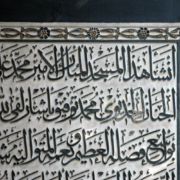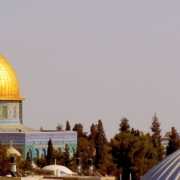What Being Anabaptist Is Not
Rob Martin | Monday, 27th June 2016
[Reposted from Abnormal Anabaptist. Originally posted on 10 May 2016.]
Over the years, since I personally rediscovered my Anabaptist roots and have spent time exploring and uncovering what it means to be an Anabaptist minded Christian, I’ve had many conversations with folks about what being an Anabaptist is. I even wrote an article here defining an Anabaptist in which I link several other articles. I participated in a Synchro-blog with other like-minded folks exploring three distinctives that we felt defined Anabaptism. But there are still people I run into who, when I mention being an Anabaptist, they say, “Yeah, I believe in adult baptism, too.” Sigh. So, in this article, I want to spend a bit of time listing a few things that Anabaptism is not.
Anabaptism is NOT about baptism. Yes, the term “Anabaptist” has to do with the concept of “rebaptizing” related to how the original folks carrying the name were given that moniker after they started baptizing grownups that had previously been baptized as infants. But the rule and timing and age of baptism was never the purpose for re-baptizing. The adult baptism comes from the idea of making a conscious, risky, radical decision to break away from institutionalized, hierarchical church into a Jesus-shaped lifestyle with baptism being performed as a public witness and a sanctification of that life dedication. Technically speaking, for a person to be “Anabaptist” in the original sense, if it were truly about baptism, they would have to be baptized at least twice. Truly, when and how often someone is baptized is not the point of Anabaptism. Who you are following is.
Anabaptism is NOT about being a pacifist. There are quite a few religions and philosophies around the world that have, at their core, a pacifistic ideology and have nothing to do with Christianity or with being an Anabaptist. However, Anabaptism does have as one of its central ideas this concept of shalom from which an Anabaptist operates. This concept is rooted, itself, in a radical love that encompasses all human beings, even those who would consider the person to be an enemy.
What’s key here is that love is the key to all human interaction. Anabaptists take very seriously Jesus’ words to love our enemies, to love our neighbors, to love other people, even if those other people are the disgusting, heretical, heathen Samaritans that obviously have their theology wrong. The Anabaptist Christian approaches every situation, even ones where wrong is being confronted, with the general question of “How do I show love to this person?” This is the example Jesus gave us, that even his strongest opponents were given respect, were answered in kind, and were treated, not as some outcast to be avoided but as humans who are brothers and sisters. If we have made the radical decision to follow Jesus, as I mentioned above, then we follow his example. And his example is to love everyone, equally, with nothing held back, even to the point of laying down our lives for those who hate us.
And going further with pacifism, Anabaptists are NOT passive. Over the centuries, the Mennonite branch of Anabaptists has taken pacifism in a direction where to be a pacifist means to avoid conflict. If there is something that is going to cause people to be in conflict, we avoid it, we cover it over, we make it into an inconsequential thing to be handled, quietly, at the next committee meeting. We Mennonites have gotten very good at avoiding conflict. And this has, unfortunately, infected our activities within the church as well as in how we interact with the world around us. We chose to just stay quiet. In our silence, though, we have let racism in our own churches go unaddressed, we’ve covered over abuses of power, both the more “acceptable” kinds as well as those that result in sexual assault. Our pacifism cannot lead us into passivism. There are ways in which we can still express our enemy love while still addressing the problems around us.
Anabaptism is NOT conservative, nor is it progressive, nor is it liberal, nor libertarian, nor any other label that we might apply to it that relates to a human based ideology. It is not a protest movement nor is it collaborative with the powers around us. An Anabaptist sets aside human structures and ways of thinking as best as possible and, again, chooses to radically follow Jesus. Sometimes that may look like what the world thinks as conservative (living by a code of morality in contrast with the world), sometimes that looks very progressive (the code of ethics of care for the poor, the marginalized, and the voiceless is very progress). And every other flavor in between. In Jesus day, he had factions to deal with as well such as Pharisees, scripts, Sadducees, Zealots, Essenes, etc., who all had a particular ideological framework by which they operated. And Jesus pretty much rubbed them all the wrong way, not because that was his aim, but because they couldn’t fit him in their neat little boxes.
For Anabaptists following after Jesus 2000+ years after he walked the earth, this can look and feel very messy. The voices and patterns of this world are very loud and very hard to keep separate from our Christian walk at times. The Spirit that Jesus left behind for us speaks so quietly that we often miss our way. But an Anabaptist seeking to follow Jesus holds very lightly to these things because they recognize the limitations to their own understanding and, instead, seek Jesus guidance through his Spirit, through the community of Christ-followers around us, and through the stories and writings in the Bible.
In our day and age where people like to categorized and classify and define things to the utmost of details, where we want to be able to very clearly put things in their proper place and perspective, Anabaptism stands out in that it is probably easier to describe what it is not and much harder to describe what it is. I’m sure that there are folks who will come along to my article here and say, “Yeah, but you didn’t talk about this” or “You need to make sure you defined that.” And those are probably good points of discussion. But ultimately, the biggest test for what I see as the Anabaptist way is whether or not I can see Jesus in it. If it doesn’t, then it doesn’t really belong in Anabaptism. And, honestly, if it doesn’t look like Jesus, I question if it should even belong in Christianity at all. And isn’t that the better question?
Rob Martin is a software validation analyst living in Southeastern Pennsylvania. He has a Masters of Arts in Missional Ministry from Biblical Theological Seminary. He blogs at Abnormal Anabaptist.





